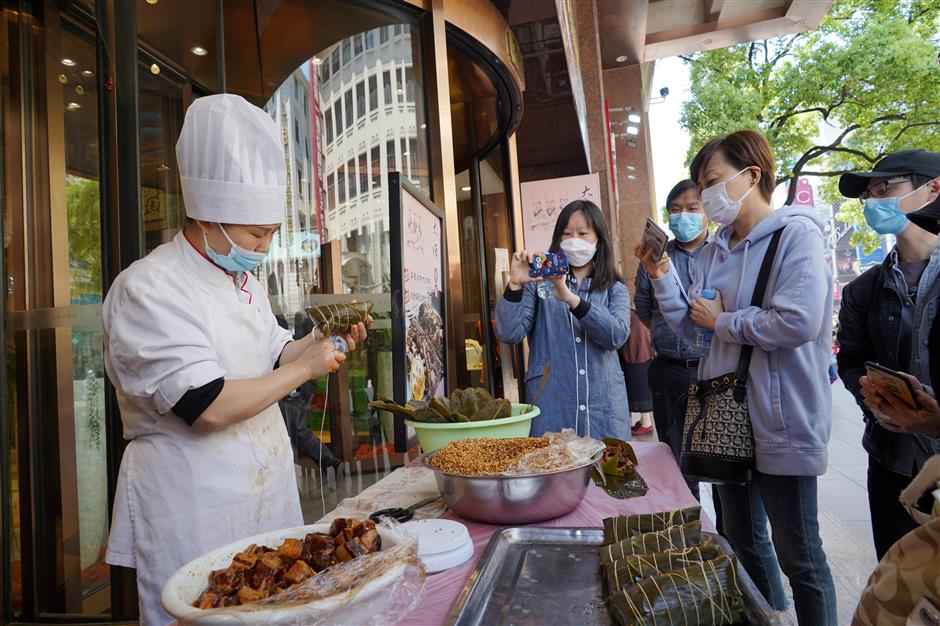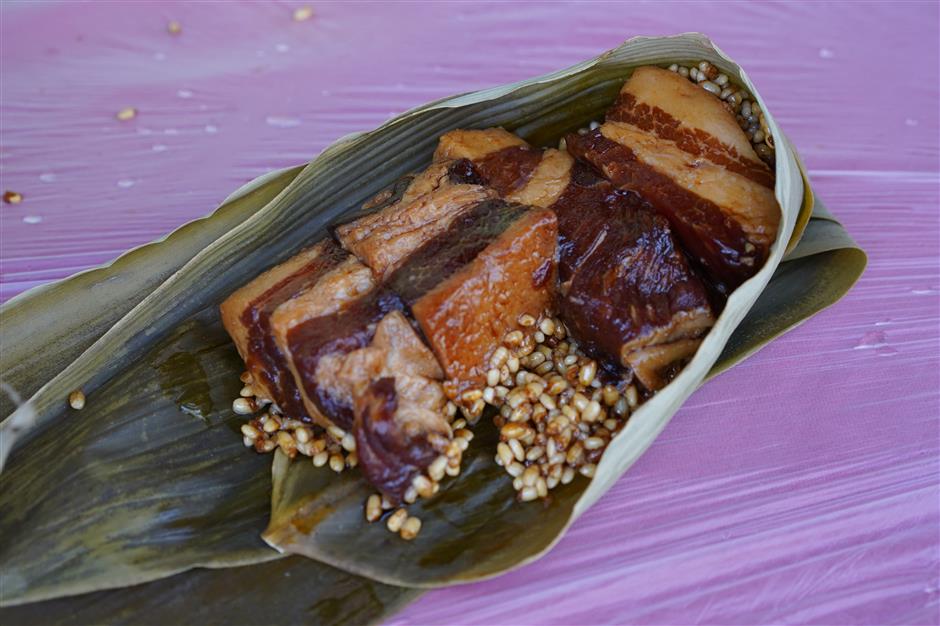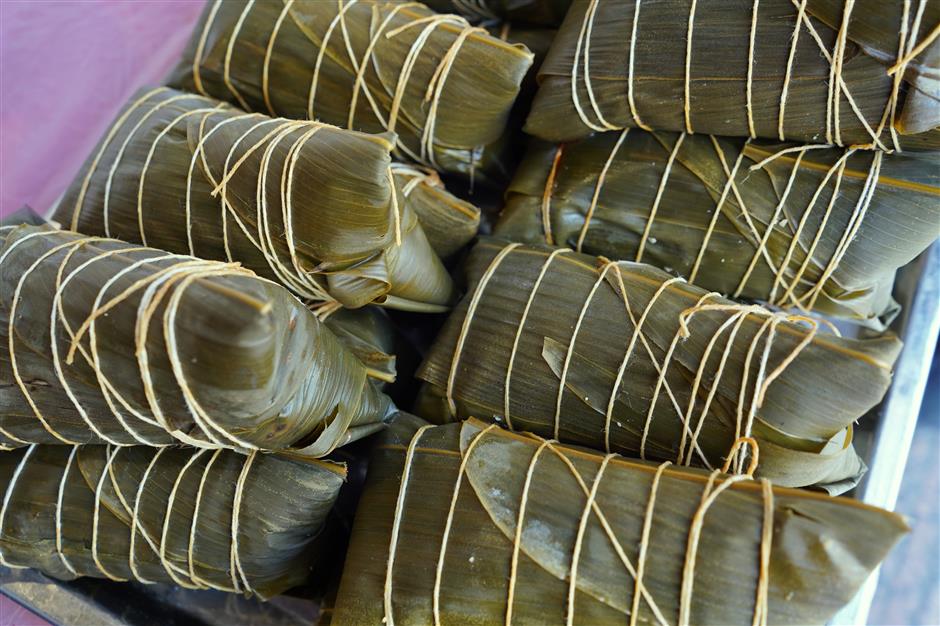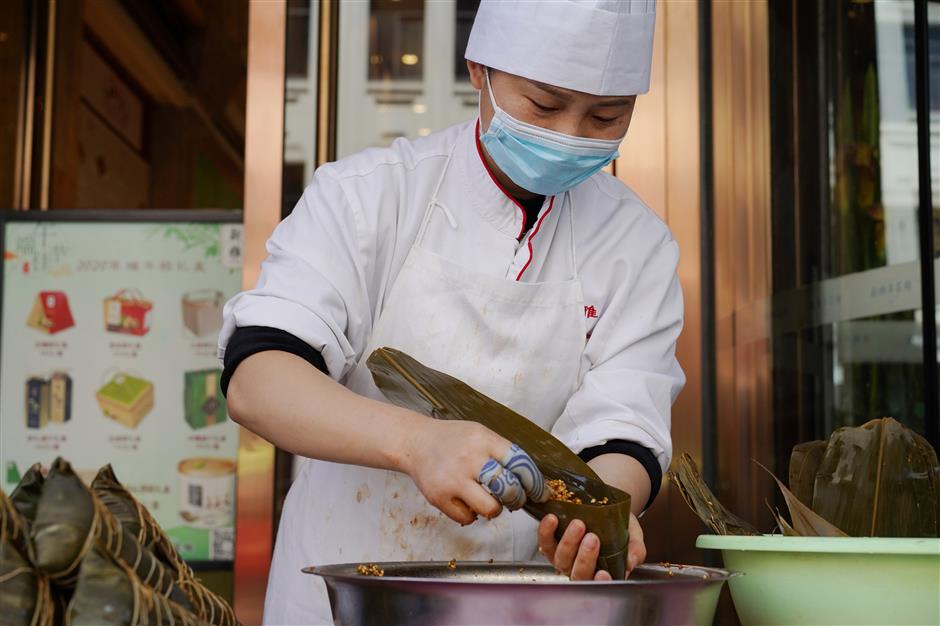
Passersby watch as Wang Shifeng makes zongzi outside the Sunya Cantonese Restaurant.

Wang Shifeng makes zongzi outside the Sunya Cantonese Restaurant on Nanjing Road Pedestrian Mall.

A half-finished zongzi by Wang Shifeng.
Months from the Dragon Boat Festival, or duanwu jie, Shanghai's streets are already filled with the fragrance of zongzi, a must food for the traditional festival.
Zongzi, one of the most best-known Chinese snacks, is made of glutinous rice stuffed with a variety of fillings and then wrapped in bamboo, reed or other large flat leaves bound with string.
A zongzi master was making the glutinous rice dumplings outside the Sunya Cantonese Restaurant on Nanjing Road Pedestrian Mall on Wednesday.
Wang Shifeng, 36, has been making zongzi for five years.
"Making zongzi seems to be simple, but it involves a number of procedures, including layering leaves together, folding the bottom into a cone, filling rice to fill the bottom, flattening rice, picking proper pork, adding meat, covering the pork with rice, wrapping, and fastening the leaves with twine," Wang told Shanghai Daily.
"It is important to pick both fat and lean meat and mix them in the rice to enrich the taste," she said.
It usually takes Wang between one and three minutes to make a zongzi depending on the quality of the reed leaves, and she makes about 380 zongzi a day.
"It is interesting to see how to make zongzi on the business street, and I only saw the process from my grandmother, who is now 89 years old and could not make them due to her eyesight and backache," said Chen Liang, a 36-year-old Shanghai resident who was passing by.
"I learned how to make zongzi from her in my childhood, but have forgot it all now," she said. “This reminds me of my childhood and it is a good memory."
The zongzi Wang makes weigh 280 grams each compared with the typical 160 to 200 grams on the market and four big pieces of pork are wrapped inside each.
"The pork zongzi are the 'Big Mac' of the zongzi field, and the ingredients are carefully selected," said executive chef Huang Renkang, who has been in the catering industry for over 40 years.
"We want to show guests how to make zongzi and provide a fun experience for customers with the demonstration," Huang said
"Chefs have compared a variety of pork based on color, fragrance and taste, and selected an imported pork finally, and the rice experiences several hours of pickling and steaming," said Huang. "The final product is fragrant and glutinous and has a smooth Shanghai flavor."

Zongzi made by Wang Shifeng.

Wang Shifeng packs rice into the leaves.
The restaurant also launched a new filling — black glutinous rice with red bean paste — for this year's festival.
The rice is made by boiling with the juice of crushed leaves freshly picked on mountains. The history of the rice use dates back to the Tang Dynasty (AD 618-907) in the Jiangnan region.
"Compared with traditional rice, the black rice is more fragrant," said Huang.
"The zongzi is fresh with the fragrance of grass and wood in the mountain when you open its leaves," said Huang.
The idea for the new recipe originated from a black glutinous rice and Chinese yam babaofan (steamed sweetened glutinous rice with eight different ingredients) the restaurant launched during the Spring Festival and which had received a good response from customers.
Zongzi with salted egg yolk and pork, red bean and jujube fillings are also among the restaurant's offerings.
"The business is recovering gradually and even booming these days," said Huang.
The restaurant launched zongzi sales just after the Qingming Festival in early April.
"The sales peak is expected around mid-May," said Huang.
At present, more than 1,000 pork zongzi a day are sold at the restaurant, and it expects that to rise to 6,000 at its peak.
"For the first time, we started sales of zongzi online with food delivery platforms amid the coronavirus pandemic, and we are confident that sales will catch up to and even surpass last year," said Huang.
His target is 200,000 compared with 100,000 last year.
“I’ve liked eating zongzi with pork filling since my childhood," said customer Sun Yao. "My mother used to make them herself, but it is difficult now as she grows old. I wilI buy some and take them home for her."
"The zongzi made by the restaurant does not taste greasy, and it has a unique fragrance," she said.
This year's Dragon Boat Festival is on June 25, on the fifth day of the fifth month of the Chinese calendar. Its origin lies in commemorating Qu Yuan, a Chinese poet from the Warring States Period (475-221 BC) who drowned himself after his motherland was invaded.
At an outlet of Shen Da Cheng, a time-honored dim sum shop, also on Nanjing Road Pedestrian Mall, zongzi with fermented bean curd flavor and pork filling, adzuki bean and salted egg yolk are served.
"I like rice dumplings without any filling, and they taste glutinous and lightly sweet," said customer Jiang Yaya. "I dip it in sugar when eating.
"Salted egg yolk filling is fresh for me as I have only tasted qingtuan, or green glutinous rice balls, with that flavor," she said. "I will buy two to have a try."
Sales of zongzi have also begun at Xing Hua Lou, which dates back to 1851, and the 75-year-old Wang Jia Sha, another two time-honored restaurants in Shanghai.
